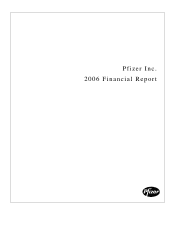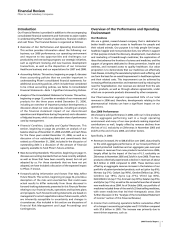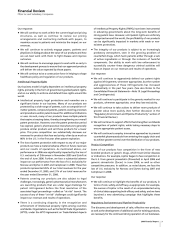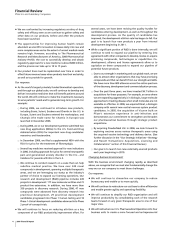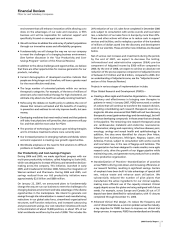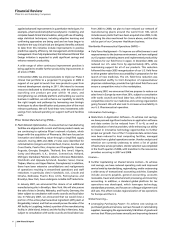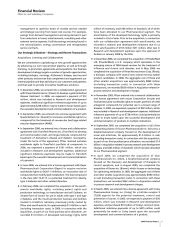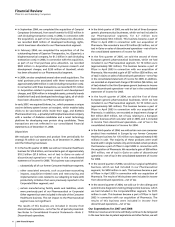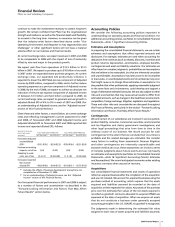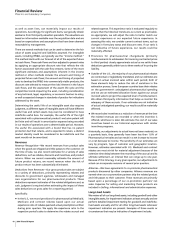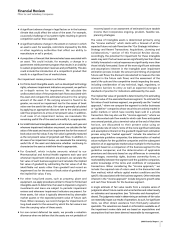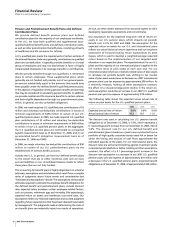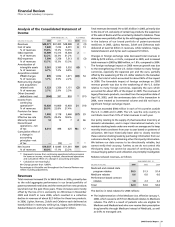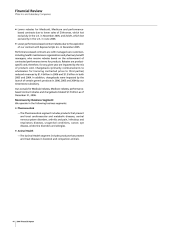Pfizer 2006 Annual Report Download - page 6
Download and view the complete annual report
Please find page 6 of the 2006 Pfizer annual report below. You can navigate through the pages in the report by either clicking on the pages listed below, or by using the keyword search tool below to find specific information within the annual report.
4 2006 Financial Report
Financial Review
Pfizer Inc and Subsidiary Companies
•
We are confronted by increasing regulatory scrutiny of drug
safety and efficacy even as we continue to gather safety and
other data on our products, before and after the products
have been launched.
•
The opportunities for improving human health remain
abundant as scientific innovation increases daily into new and
more complex areas and as the extent of unmet medical needs
remains high. However, according to The Pharmaceutical
Research and Manufacturers of America, 2006 Pharmaceutical
Industry Profile, the cost to successfully develop and obtain
regulatory approvals for a new medicine is about $800 million,
and the process can take up to 10 to 15 years.
•
Our product lines must be replenished over time in order to
offset future revenue losses when products lose their exclusivity,
as well as to provide for growth.
Our response:
•
As the world’s largest privately funded biomedical operation,
and through our global scale, we will continue to develop and
deliver innovative medicines that will benefit patients around
the world. We will continue to make the investments necessary
to serve patients’ needs and to generate long-term growth. For
example:
During 2006, we continued to introduce new products,
including Eraxis, Sutent, Exubera and Chantix in the U.S. In
Europe, Sutent and Exubera entered the marketplace, and
Champix (the trade name for Chantix in Europe) was
launched in December 2006.
During 2006, we or our development partners submitted two
new drug applications (NDAs) to the U.S. Food and Drug
Administration (FDA) for important new drug candidates:
maraviroc and fesoterodine.
In December 2006, we filed a supplemental NDA with the
FDA for Lyrica for the treatment of fibromyalgia.
Several key medicines received approval for new indications
in 2006, including approvals for Lyrica for central neuropathic
pain and generalized anxiety disorder in the E.U., and
Celebrex for juvenile arthritis in the U.S.
We continue to conduct research on a scale that can help
redefine medical practice. We have over 240 novel
compounds in development, spanning multiple therapeutic
areas, and we are leveraging our status as the industry’s
partner of choice to expand our licensing operations. Our
research and development (R&D) pipeline includes 249
projects in development: 177 new molecular entities and 72
product-line extensions. In addition, we have more than
350 projects in discovery research. During 2006, 47 new
compounds were advanced from discovery research into
preclinical development, 29 preclinical development
candidates progressed into Phase 1 human testing and 18
Phase 1 clinical development candidates advanced into Phase
2 proof-of-concept trials.
•
We will continue to focus on reducing attrition as a key
component of our R&D productivity improvement effort. For
several years, we have been revising the quality hurdles for
candidates entering development, as well as throughout the
development process. As the quality of candidates has
improved, the development attrition rate has begun to fall. Our
goal is to launch four new products a year from internal
development beginning in 2011.
•
While a significant portion of R&D is done internally, we will
continue to seek to expand our pipeline by entering into
agreements with other companies to develop, license or acquire
promising compounds, technologies or capabilities. Co-
development, alliance and license agreements allow us to
capitalize on these compounds to expand our pipeline of
potential future products.
Due to our strength in marketing and our global reach, we are
able to attract other organizations that may have promising
compounds and that can benefit from our strength and skills.
We have more than 800 alliances across the entire spectrum
of the discovery, development and commercialization process.
Over the past three years, we have invested $6.7 billion in
acquisitions for these purposes. For example, an area where
we are expanding aggressively is in biologics, large-molecule
approaches to treating disease when small molecules are not
available or effective. In 2006, we acquired Rinat, a biologics
company with several new central-nervous-system product
candidates. In 2005, the acquisition of Vicuron built on
Pfizer’s extensive experience in anti-infectives and
demonstrates our commitment to strengthen and broaden
our pharmaceutical business through strategic product
acquisitions.
By acquiring PowderMed Ltd. in 2006, we look forward to
exploring vaccines across various therapeutic areas using
the acquired vaccine technology and delivery device. (See
further discussion in the “Our Strategic Initiatives—Strategy
and Recent Transactions: Acquisitions, Licensing and
Collaborations” section of this Financial Review.)
Our goal is to launch two new externally-sourced products
each year beginning in 2010.
Changing Business Environment
With the business environment changing rapidly, as described
above, we recognize that we must also fundamentally change the
way we run our company to meet those challenges.
Our response:
•
We will continue to streamline our company to reduce
bureaucracy and enable us to move quickly.
•
We will continue to restructure our cost base to drive efficiencies
and enable greater agility and operating flexibility.
•
We will continue to simplify our R&D organization and will
improve productivity by consolidating each of the research
teams focused on any given therapeutic area to one of four
major sites.
•
We will restructure our U.S. Pharmaceutical Operations into four
business units to create a more focused and entrepreneurial

